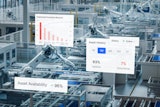
 Daniel Erickson
Daniel Erickson Good things CAN come to those who wait. Historically, big business, with its depth of resources, has held the key to unlocking the fortress of Big Data. But no longer. Today, cost-effective predictive analytics (PA) tools are putting the power of Big Data into the hands of small-to-medium-sized businesses (SMBs). Increasing interest and recognition of the need for PA, developers crafting their response to this demand, expanding open-source coding and information sharing and cloud availability, plus templated solutions have led to the opportunity for SMB’s to capitalize on the lowered costs of Predictive Analytics solutions.
Growing Interest and Recognition of Need for Predictive Analytics
According to research by the International Institute for Analytics and sponsored by Dell, Inc., 33 percent of survey respondents anticipate gaining competitive advantage through the successful mining of Big Data.. Additionally, the 2016 Global Manufacturing Competitiveness Index (GMCI), conducted by Deloitte and the Council on Competitiveness, gathered the opinions of over 500 global executives pertaining to the key drivers of manufacturing competitiveness. In order of importance, predictive analytics ranked first for the United States and China. There is a growing interest and recognition by companies of the need to increase usage of PA within manufacturing companies.
PA takes a company’s existing data and scrutinizes it, recognizing patterns that, in concert with human intelligence, can be used to anticipate economic trends, consumer behaviors, project outcomes, risk or the like. PA’s seamless integration to historical data, pre-defined predictive models, and simplified what-if analysis provide instant insight into what is driving the series of patterns and where a business is likely headed. Predictive analytics asks, “What is probable to happen?”
According to CEO Ray Major, of Halo BI, predictive analytics is high on the complexity and business value scale when compared to other advanced analytic tools available through BI; only prescriptive analytics ranks higher (what actions should be taken). On the lowest end of the complexity/value scale is reporting (what happened), followed successively by analysis (why did it happen) and monitoring (what’s happening now), and forecasting (what might happen). Each increasing level of complexity requires more data and more use of human intelligence. And, typically, the more dollars spent, the higher the value to business, notes Major.
“(Of) companies who have implemented predictive analytics, two-thirds of them say it adds value to their business,” said Major.
Manufacturers see the value of using PA as it can be applied to a business in various ways: client acquisition, customer experience, budget creation, sales forecasting, demand planning, manufacturing process defect tracking, inventory management, supply chain management and quality improvement, to name a few.
Increasing Numbers of Technology Companies Racing to Meet the Demand
As companies are becoming more interested in using their data for business analytics, software developers are scrambling to craft their response to the interest. This is spurring more activity and creativity with the use of open-source code (developed as a public collaboration and freely available), information sharing and the development of partnerships between software companies. This influx in heated competition, in turn, is driving down pricing and making PA more affordable for SMBs. Today, PA and its use in helping business make informed decisions is becoming mainstream. SoftwareAdvice has identified 87 solutions in the marketplace today, and who knows how many others are poised for debut. With targeted industry solutions and more developers entering the arena, cost to the consumer is being reduced due to competition.
Three years ago, it may have cost Fortune 500 clients $1.36 million to implement predictive analytics with an annual support cost between $600,000 to one million a year to keep the analytics running. Today, enterprise organizations’ annual investment begins at $500,000, while a medium-sized business of from 500 to 5,000 employees invest $100,000 or more annually, according to research by the IIA.
Availability of Cloud Solutions Options
Utilizing a cloud-based solution offers per-use and subscription services which are flexible and come with an affordable price tag for small and mid-sized manufacturers unable to host an on-site system or hire a department of data analysts. Crunching Big Data into Smart Data therefore may cost less via a cloud or web-based BI solution with various pre-packaged, off-site, browser-based options abounding.
A 2014 Decision Management Solutions’ survey of 350 respondents from various industries indicated that the primary driver for the use of cloud-based solutions was reduced cost, according to Analytics Magazine.
Industry-Specific PA Templates Deliver Targeted Solutions
Customization in the software realm has typically increased the monetary investment. However, in the case of PA, various vendors — keenly knowledgeable of specific industries such as manufacturing and retail — are using this expertise to create industry-specific software templates. Companies can access information pertaining to their needs and in their vernacular to perform relevant what-if analysis, foresee challenges or potential disruptions, and manage their risk. These newly-developed templated solutions, targeted to a specific industry, have resulted in a lower price tag. When the software solution is specifically designed for a company’s particular industry, it makes for a very powerful business tool.
Relating PA and My Business Data
When predictive analytics is integrated with a business system such as an Enterprise Resource Planning (ERP) technology solution, manufacturers are able to utilize and visualize their business data in very compelling ways, enabling enhanced decision-making. Interactive dashboards and mobile access contribute to self-sufficiency throughout an organization, streamlining procedures for increased efficiency and profitability. Graphing, sorting and drilling into critical business information in any way — combined with robust pre-built reports, metrics and KPIs — has become an essential tool for countless small to mid-sized manufacturers. Many businesses discover that antiquated systems, conflicting spreadsheet reports and cobbled software packages operating in silos throughout the company, simply cannot perform to expectations. A powerful system which includes BI, ERP, and predictive analytics can keep pace with today’s technology to ascertain the best strategy for investing time and money.
Undeniably, predictive analytics software is gaining in popularity. More businesses are recognizing the need for PA. A growing number of software companies are collaborating and competing with one another. Demand and cloud solutions are driving down the cost as software companies compete for this business, and PA templates designed for specific industries, such as manufacturing, have put the product within reach as a solution for SMBs. Bottom line: predictive analytics can help companies analyze, decide, and plan more quickly with easy-to-use, pre-packaged self-service solutions that are becoming more affordable every day.
Daniel Erickson is a Product Strategy Manager at ProcessPro.






















